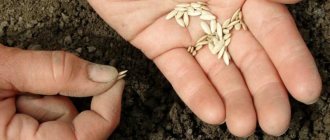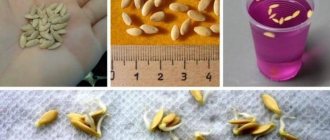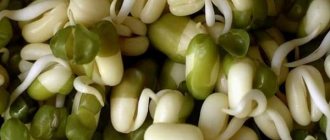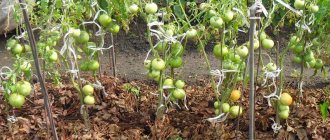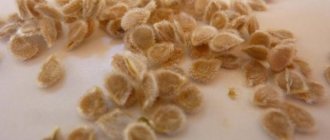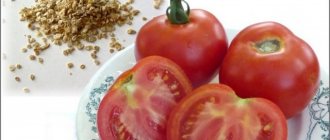What to do to make dill sprout quickly
Preparation of planting material begins a week before planting. Treatment is carried out for rapid germination and disinfection to get rid of pathogens of viral and fungal diseases.
Let's look at what the seeds are soaked in before planting.
Water
Place a cotton cloth or gauze on the bottom of the plate, sprinkle seeds and fill with filtered water. The liquid temperature for heat-loving varieties should be 20–25 °C, for others - 15–20 °C.
The water must be changed every 4 hours. During soaking, the seeds should just swell. Once 1–1.5% of the seed material has hatched, the process is complete. Shoots from such seeds appear 2-3 days earlier than when sowing dry ones.
Growth stimulants
For soaking, products containing magnesium, iron, copper, boron, molybdenum, zinc and cobalt are used. Stimulants promote the growth process and awaken the embryos. Disinfected and heated seeds are soaked in a solution, then dried, but not washed, and planted.
The most commonly used growth stimulants:
- " Zircon " is a biological product with systemic action. Activates germination and germination of seed material, increases productivity.
- " Fitosporin " is a systemic fungicide. Suppresses the proliferation of fungi and bacteria.
- " Kornevin " is a biostimulating drug that contains indolylbutyric acid.
- " Epin " is a natural bioregulator, growth and development stimulator, containing epibrassinolide.
Vodka
40% vodka not only dissolves essential oils, which promotes rapid germination, but also disinfects seeds. To do this, planting material is placed in cotton cloth and dipped in vodka for 15 minutes, no more.
Wood ash
The action of the solution is based on the high content of microelements, in particular potassium and calcium. Before soaking, prepare a solution: 2 tbsp. l. ash is poured into 1 liter of water and left for 2 days, stirring occasionally. Dill seeds are placed in the strained solution in a fabric bag for 4-5 hours.
Herbal infusions
Pour 1 tsp into a cup. chamomile, pour boiling water (90–95 °C), cool to 50 °C and soak the seeds for half an hour. You can also use aloe juice: dilute with water 1:1 and place the planting material in the infusion for a day.
This is interesting:
Areas of application for dill umbrellas.
A tasty and healthy way to fight excess weight: dill for weight loss.
Germination time of dill at home on the windowsill
At home, the crop is grown for constant consumption of fresh greens. Unlike natural conditions, home cultivation can affect the germination period and yield of the crop. If dill receives enough light, then at a room temperature of about 20 degrees and good soil moisture in the container, it will sprout in 10-13 days.
Due to the inability to grow leaves instead of cut ones for a permanent harvest, it is recommended to sow dill every 10-12 days in a container on the windowsill.
When growing indoors, it is not so much the germination time of dill that is important, but the lush mass of greenery. Experts do not recommend choosing early-ripening crop varieties in order to achieve early germination. It is better to choose late-ripening species that will hatch a few days later than their early counterparts, but will provide rich foliage instead of long stems.
Disinfection
After soaking, the seeds must be pickled:
- To prevent diseases, swollen seeds are placed in a bright pink infusion of potassium permanganate for 20–30 minutes.
- Hydrogen peroxide has bactericidal properties. The seeds are placed in a 3% peroxide solution for 5–10 minutes.
- Treating seeds with the universal fungicide “Fundazol” protects the crop from many diseases. The solution is prepared in accordance with the instructions.
After treatment with fungicides and stimulants, the seeds are washed and dried until they flow.
Factors influencing crop germination
The germination time of dill varies depending on many reasons that must be taken into account when planting the crop.
Landing dates
This factor is relevant when sowing in open ground:
- You can start sowing dill early - April 5-10. In this case, the seeds are placed unsoaked directly on the frozen ground. As the remaining snow melts, the planting material will gain the necessary moisture and hatch.
- The optimal time for spring planting is considered to be the end of April (20-25th), when the ground has warmed up sufficiently.
- Winter sowing is carried out in October-November - this allows dill to sprout in the spring 10-14 days earlier.
Soil condition
Despite the unpretentiousness of dill, the soil on which the seeds are planned to be planted must be adapted for normal growth of greenery. With high soil oxidation, there is a high probability of absolute non-germination or a significant slowdown in the hatching of planting material. Lack of moisture and dry soil will prevent the seeds from swelling and slow down the appearance of the first leaves in the garden.
Lighting
It is believed that for healthy shoots and full growth of dill, the daylight hours should be at least 15 hours. For this reason, for planting crops, choose illuminated places in the open area of the garden and provide full lighting in the greenhouse and on the windowsill.
Seed quality
So that waiting for germination does not become useless for sowing dill, you need to choose only high-quality planting material. To do this, seeds collected from your garden need to be properly stored until planting.
To avoid poor germination of dill, you should purchase seeds from specialized stores.
The quality of planting material is checked using this method: the seeds are immersed in water, the good ones sink to the bottom, and the unsuitable ones remain floating on the surface.
Landing
There are a number of rules that must be followed when sowing dill in the ground. Deviation from planting norms significantly affects the timing and quality of crop germination.
Important points:
- Moistening the soil before planting . In an open area, seeds planted in dry soil will sprout only after rain. In greenhouse or home conditions, they will not be able to gain enough moisture without initial watering.
- Sprouted seeds should not be thrown into the furrows - this can lead to the seedlings being knocked off and broken. The sprouted planting material is laid out carefully.
- It is forbidden to plant germinated seeds in dry soil - this will lead to the death of the planting material.
- It is prohibited to plant seeds to a depth of more than 2-3 cm - this significantly delays the germination period of dill.
- You should not thicken the sowing in the garden bed too much - it is optimal to use 1 g of planting material per 1 square meter. m plot. The furrows are made at a distance of 4-5 cm from each other.
- When growing at home, it is better to plant seeds directly on top of the soil , evenly sprinkling the top with a thin layer of soil.
- Thin out very dense seedlings so that they do not interfere with neighbors, growing greenery.
When will dill sprout after planting?
The first sprouts of dill, the seeds of which have been germinated, appear after 7-10 days.
Let's look at how to speed up germination. There are several factors influencing the process of seed germination:
- Warm . In warm weather, seeds germinate much faster than in early spring. At an air temperature of 20 °C, the first shoots may appear within 4 days.
- Regular watering . Lack of watering in dry weather delays the process.
- The planting depth should not be more than 2 cm.
- Another important factor is the composition and structure of the soil . Neutral, loose soil is considered the best option.
How long does it take for dill to sprout in a greenhouse?
Dill is mainly grown in large volumes in heated greenhouses. The timing of seed germination in a greenhouse depends on watering and temperature conditions. Dill in greenhouse conditions sprouts 12-14 days after planting, but this indicator depends on the specific crop variety.
Early ripening varieties
These types of crops are able to germinate first and produce a harvest 35 days after sowing. However, they are not recommended for planting in greenhouse conditions, because compared to late dills, they produce less foliage and begin to actively bloom after the formation of 6 leaves on the stem. Basically, early ripening varieties are used to obtain the first greens for salads and to collect umbrellas and stems for canning.
Common varieties:
- Aurora;
- Griboyedovsky;
- Further.
Mid-season varieties
The stem of dill begins to form a week later than the early species, which allows the foliage to gain the necessary mass for good yield. Mid-season varieties of dill are considered optimal for growing in a greenhouse. They germinate 14-18 days after planting in protected soil, subject to all conditions.
Main varieties:
- Bushy;
- Leafy;
- Lesnogorodsky.
Late ripening varieties
These dill varieties are ideal for growing in heated greenhouses all year round. Due to the close proximity of internodes, they are called bush plants. Lush greens, which emerge a little later than early and medium varieties, are ideal for storage and rich in vitamins.
Common varieties:
- Dill;
- Alligator;
- Kibray.
Advice from experienced gardeners
To ensure that your garden has its own dill all summer, experienced gardeners recommend planting it in stages.
The first sowing can be done in April, after the snow has melted, on beds prepared in the fall (with added organic and mineral fertilizers). In the northern regions a little later, in May. These seeds do not need to be germinated; washing is sufficient. If seedlings emerge too early, they will suffer from spring frosts.
The second planting is carried out in August with seeds with preliminary soaking so that the dill has time to reach commercial ripeness.
Starting from the first spring planting, every 3 weeks a new batch of dill is sown with sprouted seeds. When one batch enters the flowering phase, the other begins to gain green mass, and so on until autumn.
In November, dill is planted before winter. Seeds for winter planting are not germinated or watered after planting. Winter dill produces its first harvest 1-2 weeks earlier than the first spring sowing.
Preparing seeds for rapid germination
To prepare seeds for rapid germination, it is necessary to take into account the required sowing time. They, in turn, may vary depending on the growing region, soil conditions and atmospheric conditions.
in autumn
At this time of year, sowing is carried out in order to obtain an early harvest. Already at the beginning of spring you will receive spicy herbs to your table. Seeds that have safely overwintered in the soil grow 2 weeks earlier than spring sowing. However, when sowing in autumn, there is a risk that the plants will freeze during late frosts.
In spring and summer
Dill can withstand temperatures down to -3°C, so the first sowing can be done immediately after the snow melts. If you are lucky with the weather conditions and the spring brings warm weather with a temperature of +10°C, then the harvest will be able to be harvested in April.
Errors when soaking
Typical mistakes when soaking seeds are:
- Placing seeds in the solution for too long. There is a risk that the dill will simply “suffocate”, which will reduce the germination of the seeds. You just need to keep an eye on the time, and it is better to use damp gauze rather than a bag if you plan to soak for longer than 1-2 hours.
- Using too concentrated a solution of chemicals will result in burns and damage to the shell, or even the embryo. You can avoid it by following the solution preparation technology.
- The solution is too hot when soaking, not when dipping into boiling water. You need to monitor the temperature and do not use liquid warmer than the human body. If a finger dipped into the solution feels warm, it is better to let the solution cool a little.
What to soak seeds in
You don’t have to worry about preparing the liquid and use regular tap water. However, many experienced gardeners still recommend using melted, spring or purified water for this purpose.
Growth stimulants
Today, there are several ready-made growth stimulants that can be purchased in the store:
All of them are of plant origin and are designed to accelerate not only the growth of plants, but also the germination of germs.
Herbal infusions
In the absence of ready-made drugs, you can use home remedies. They are prepared from raw materials of medicinal plants in the form of strong infusions and decoctions. The following can be used as a basis for preparing the solution:
Wood ash
As you know, this simple fertilizer is an excellent source of microelements. They are exactly what is needed at the moment when the first sprout gains strength. To prepare the solution, wood ash is poured with water in a ratio of 2 tablespoons per liter of water. Leave for two days and then filter through cheesecloth. The filtrate is used to soak the seeds.
How to get dill seeds
Dill seeds in the photo
Grow dill from a trusted supplier:
